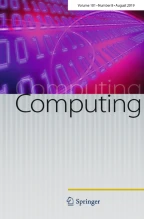Zusammenfassung
Floyd entwickelte einen Matrixalgorithmus zur Bestimmung der Längen aller kürzesten Wege in einem Netzwerk. In der vorliegenden Arbeit wird gezeigt, daß, falls man den Begriff des Netzwerkes etwas verallgemeinert, sich mit Hilfe des gleichen Verfahrens eine Fülle von grundverschiedenen Problemen lösen läßt. Es wird eine entsprechende Theorie entwickelt und an Beispielen erläutert.
Abstract
Floyd developed a matrix algorithm to find all shortest paths in a network. If we modify the algebraic structure of the network the same algorithm can be applied to large number of other problems. A general theory for these algorithms is developed and applied to numerous problems.
Explore related subjects
Discover the latest articles, news and stories from top researchers in related subjects.Literatur
Berge, C.: Theorie des graphes et ses applications. Paris: Dunod. Englische Übersetzung vonA. Doing, London: Methuen. 1962.
Caré, B. A.: An algebra for network routing problems. Journal of the Institute of Mathematics and its Applications7, 273–293 (1971).
Dantzig, G. B.: All shortest routes in a graph, in: Theory of graphs, International Symposium, Rom, 1966, S. 91–92. New York: Gorden & Breach.
Floyd, R. W.: Algorithm 97, shortest path. Communications of the A. C. M.5, 345 (1962).
Hammer, R. L.: Pseudo-boolean remarks on balanced graphs. Operations Research, Statistics and Economics Mineograph Series No. 34, University of Montreal. 1969.
Harary, F., R. Z. Norman, andD. Cartwright: Structural models. An introduction to the theory of directed graphs. New York-London-Sydney: J. Wiley. 1965.
Murchland, J. D.: A new method for finding all elementary paths in a complete directed graph. Report LBS-TNT-25, Transport network theory unit, London Graduate School of Business Studies (March 1966).
Warshall, S.: A theorem on boolean matrices. J. A. C. M.9, 11–18 (1962).
Author information
Authors and Affiliations
Rights and permissions
About this article
Cite this article
Brucker, P. ℜ-Netzwerke und Matrixalgorithmen. Computing 10, 271–283 (1972). https://doi.org/10.1007/BF02316913
Received:
Issue Date:
DOI: https://doi.org/10.1007/BF02316913
